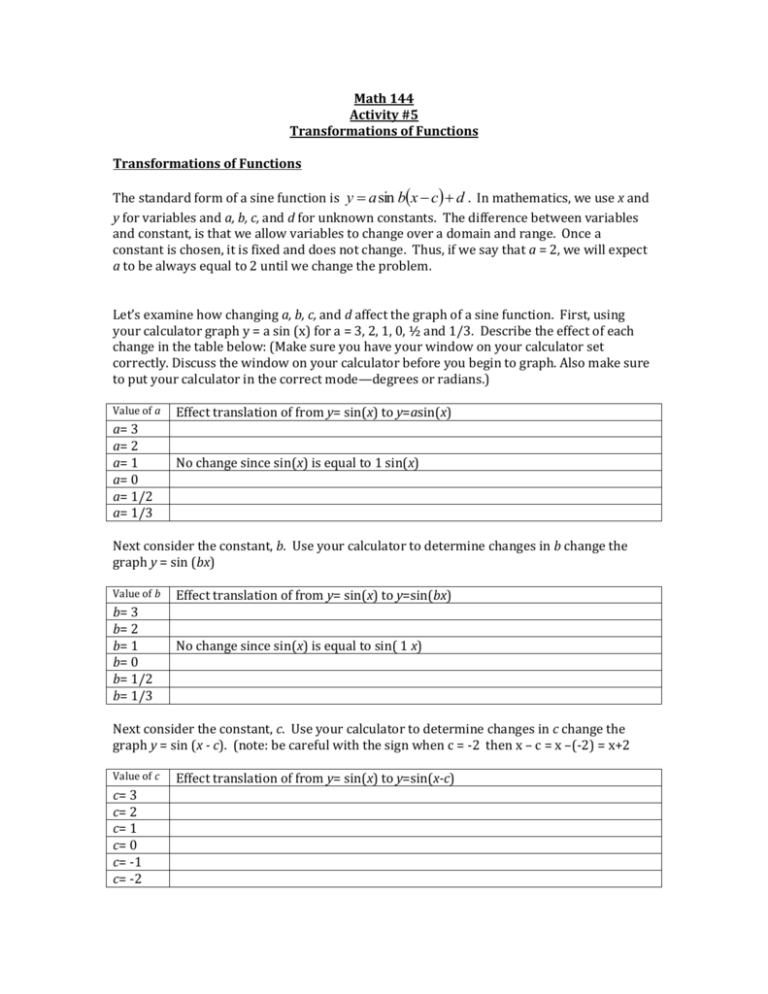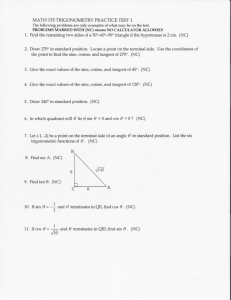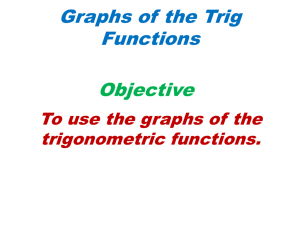Math 144 Activity #5 Transformations of Functions Transformations
advertisement

Math 144 Activity #5 Transformations of Functions Transformations of Functions The standard form of a sine function is y a sin bx c d . In mathematics, we use x and y for variables and a, b, c, and d for unknown constants. The difference between variables and constant, is that we allow variables to change over a domain and range. Once a constant is chosen, it is fixed and does not change. Thus, if we say that a = 2, we will expect a to be always equal to 2 until we change the problem. Let’s examine how changing a, b, c, and d affect the graph of a sine function. First, using your calculator graph y = a sin (x) for a = 3, 2, 1, 0, ½ and 1/3. Describe the effect of each change in the table below: (Make sure you have your window on your calculator set correctly. Discuss the window on your calculator before you begin to graph. Also make sure to put your calculator in the correct mode—degrees or radians.) Value of a a= 3 a= 2 a= 1 a= 0 a= 1/2 a= 1/3 Effect translation of from y= sin(x) to y=asin(x) No change since sin(x) is equal to 1 sin(x) Next consider the constant, b. Use your calculator to determine changes in b change the graph y = sin (bx) Value of b b= 3 b= 2 b= 1 b= 0 b= 1/2 b= 1/3 Effect translation of from y= sin(x) to y=sin(bx) No change since sin(x) is equal to sin( 1 x) Next consider the constant, c. Use your calculator to determine changes in c change the graph y = sin (x - c). (note: be careful with the sign when c = -2 then x – c = x –(-2) = x+2 Value of c c= 3 c= 2 c= 1 c= 0 c= -1 c= -2 Effect translation of from y= sin(x) to y=sin(x-c) Next consider the constant, d. Use your calculator to determine changes in d change the graph y = sin (x ) + d . Value of d Effect translation of from y= sin(x) to y=sin(x) + d d= 3 d= 2 d= 1 d= 0 d= -1 d= -2 Exploring transformations further (cosine) In this section, without using a calculator, for each equation below tell us whether the number in the problem is in the a, b, c or d location and describe how the number will translate the cosine graph. y = cos (2 x) The 2 is in the place of letter ______ The translation of this graph is? y = ½ cos ( x) The ½ is in the place of letter ______ The translation of this graph is? y = cos ( x) + 3 The 2 is in the place of letter ______ The translation of this graph is? y = cos (1/3 x) The 1/3 is in the place of letter ______ The translation of this graph is? y = cos ( x) + 5 The 5 is in the place of letter ______ The translation of this graph is? Match the equation with the graph. Below are three equations. Match these equations with graphs A, B, C or D and explain why you chose the graph. 𝜋 2 matches with graph ______. Why y = cos ( x - 2 ) 𝜋 matches with graph ______. Why y = cos ( x +𝜋) matches with graph ______. Why y = cos ( x + ) A C B D Changing to standard form: First let’s distribute 𝜋 3 ( 𝑥 − 6 ) = ____________________ The distribution process allows you to change the equation to match the correct form. The standard form of the sine and cosine functions are: y a sin bx c d y a cos b( x c) d For the following equations, rewrite to standard notation and give the actual values of a, b, c and d 𝑦 = 3 sin(4𝑥 + 𝜋) + 2 a= _____ b= ______ c= ______ d= ________ 1 𝑦 = −3 sin ( 𝑥 + 2𝜋) + 2 2 a= _____ b= ______ c= ______ d= ________ 𝑦 = 4 − 2 sin(6𝑥) a= _____ b= ______ c= ______ d= ________ 𝑦 = sin(4𝑥 − 𝜋) − 𝜋 a= _____ b= ______ c= ______ d= ________ 𝑦 = 3 cos (4𝑥 + 𝜋) + 2 a= _____ b= ______ c= ______ d= ________ 1 𝑦 = −3 cos ( 𝑥 + 2𝜋) + 2 2 a= _____ b= ______ c= ______ d= ________ 𝑦 = 4 − 2 cos(6𝑥) a= _____ b= ______ c= ______ d= ________ 𝑦 = cos(4𝑥 − 𝜋) − 𝜋 a= _____ b= ______ c= ______ d= ________ Defining the translations: Define the translations created by each constant in the standard equation. Try for as much detail as possible including how does positive and negative numbers change the translation, what about large absolute value (greater than one) and small absolute values (less than one) affect the translations. The translations for a are defined as: The translations for b are defined as: The translations for c are defined as: The translations for d are defined as: You now have a definition for the translations keep these in mind and throughout the semester and refine the definitions as often as necessary. For the following, explain the transformations that are applied to y = cos x and y = sin x. Sketch the graph. Be sure to use an appropriate scale for both the x- and y-axis. 1. y = -1-sin(3x + p ) 2. y = æ 1 pö cos ç 2x - ÷ - 3 è 2 2ø æ è 3. y = 3+ 4sin ç p x + 4. x ( t ) = 5sin ( p t ) pö ÷ 3ø æ è 5. x ( t ) =10sin ç 4p t - pö ÷ 2ø






